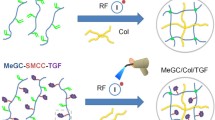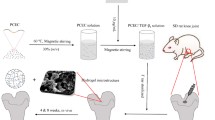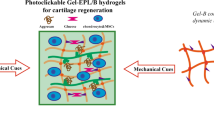Abstract
In this study, chondrocytes were encapsulated into an injectable, in situ forming type II collagen/hyaluronic acid (HA) hydrogel cross-linked with poly(ethylene glycol) ether tetrasuccinimidyl glutarate (4SPEG) and supplemented with the transforming growth factor β1 (TGFβ1). The chondrocyte–hydrogel constructs were cultured in vitro for 7 days and studied for cell viability and proliferation, morphology, glycosaminoglycan production, and gene expression. Type II collagen/HA/4SPEG formed a strong and stable hydrogel, and the chondrocytes remained viable during the encapsulation process and for the 7-day culture period. In addition, the encapsulated cells showed spherical morphology characteristic for chondrocytic phenotype. The cells were able to produce glycosaminoglycans into their extracellular matrix, and the gene expression of type II collagen and aggrecan, genes specific for differentiated chondrocytes, increased over time. The results indicate that the studied composite hydrogel with incorporated chondrogenic growth factor TGFβ1 is able to maintain chondrocyte viability and characteristics, and thus, it can be regarded as potential injectable cell delivery vehicle for cartilage tissue engineering.






Similar content being viewed by others
References
Poole AR, Kojima T, Yasuda T, Mwale F, Kobayashi M, Laverty S. Composition and structure of articular cartilage: a template for tissue repair. Clin Orthop Relat Res. 2001;391:S26–33.
Chung C, Burdick JA. Engineering cartilage tissue. Adv Drug Deliv Rev. 2008;60(2):243–62.
Mollenhauer JA. Perspectives on articular cartilage biology and osteoarthritis. Injury. 2008;39:S5–12.
Brittberg M, Lindahl A, Nilsson A, Ohlsson C, Isaksson O, Peterson L. Treatment of deep cartilage defects in the knee with autologous chondrocyte transplantation. N Engl J Med. 1994;331(14):889–95.
Brittberg M. Autologous chondrocyte implantation–technique and long-term follow-up. Injury. 2008;39:S40–9.
Melero-Martin JM, Al-Rubeai M (2007) In Vitro Expansion of Chondrocytes. In: Ashammakhi N, Reis R, Chiellini E, editors. Topics in Tissue Engineering. 2007;chapter 1,pp. 1–37
Gaissmaier C, Koh JL, Weise K. Growth and differentiation factors for cartilage healing and repair. Injury. 2008;39:S88–96.
Lu L, Valenzuela RG, Yaszemski MJ. Articular cartilage tissue engineering. e-biomed. J Regen Med. 2000;1:99–114. doi:10.1089/152489000420113.
Vinatier C, Bouffi C, Merceron C, Gordeladze J, Brondello JM, Jorgensen C, et al. Cartilage tissue engineering: towards a biomaterial-assisted mesenchymal stem cell therapy. Curr Stem Cell Res Ther. 2009;4(4):318–29.
Frenkel SR, Di Cesare PE. Scaffolds for articular cartilage repair. Ann Biomed Eng. 2004;32(1):26–34.
Kim IL, Mauck RL, Burdick JA. Hydrogel design for cartilage tissue engineering: a case study with hyaluronic acid. Biomaterials. 2011;32(34):8771–82.
Lum L, Elisseeff J. Injectable Hydrogels for Cartilage Tissue Engineering. In: Ashammakhi N, Ferretti P, editors. Topics in Tissue Engineering. 2003;chapter 4,pp. 1−25
Amini AA. Nair LS (2012) Injectable hydrogels for bone and cartilage repair. Biomed Mater. 2012;7(2):024105.
Spiller KL, Maher SA, Lowman AM. Hydrogels for the repair of articular cartilage defects. Tissue Eng Part B Rev. 2011;17(4):281–99.
Taguchi T, Xu L, Kobayashi H, Taniguchi A, Kataoka K, Tanaka J. Encapsulation of chondrocytes in injectable alkali-treated collagen gels prepared using poly(ethylene glycol)-based 4-armed star polymer. Biomaterials. 2005;26(11):1247–52.
Collin EC, Grad S, Zeugolis DI, Vinatier CS, Clouet JR, Guicheux JJ, et al. An injectable vehicle for nucleus pulposus cell-based therapy. Biomaterials. 2011;32(11):2862–70.
Grimau E, Heymann D, Redini F. Recent advances in TGF-β effects on chondrocyte metabolism. Potential therapeutic roles of TGF-β in cartilage disorders. Cytokine Growth Factor Rev. 2002;13(3):241–57.
Blaney Davidson EN, van der Kraan PM, van den Berg WB. TGF-β and osteoarthritis. Osteoarthr Cartil. 2007;15(6):597–604.
Pulkkinen HJ, Tiitu V, Valonen P, Hamalainen ER, Lammi MJ, Kiviranta I. Recombinant human type II collagen as a material for cartilage tissue engineering. Int J Artif Organs. 2008;31(11):960–9.
Nehrer S, Breinan HA, Ramappa A, Young G, Shortkroff S, Louie LK, et al. Matrix collagen type and pore size influence behaviour of seeded canine chondrocytes. Biomaterials. 1997;18(11):769–76.
Nehrer S, Breinan HA, Ramappa A, Shortkroff S, Young G, Minas T, et al. Canine chondrocytes seeded in type I and type II collagen implants investigated in vitro. J Biomed Mater Res. 1997;38(2):95–104.
Nehrer S, Breinan HA, Ramappa A, Hsu HP, Minas T, Shortkroff S, et al. Chondrocyte-seeded collagen matrices implanted in a chondral defect in a canine model. Biomaterials. 1998;19(24):2313–28.
Veilleux NH, Yannan IV, Spector M. Effect of passage number and collagen type on the proliferative, biosynthetic, and contractile activity of adult canine articular chondrocytes in type I and II collagen-glycosaminoglycan matrices in vitro. Tissue Eng. 2004;10(1–2):119–27.
Bosnakovski D, Mizuno M, Kim G, Takagi S, Okumura M, Fujinaga T. Chondrogenic differentiation of bovine bone marrow mesenchymal stem cells (MSCs) in different hydrogels: influence of collagen type II extracellular matrix on MSC chondrogenesis. Biotechnol Bioeng. 2006;93(6):1152–63.
Lu Z, Doulabi BZ, Huang C, Bank RA, Helder MN. Collagen type II enhances chondrogenesis in adipose tissue-derived stem cells by affecting cell shape. Tissue Eng Part A. 2010;16(1):81–90.
Chang CH, Lin FH, Kuo TF, Liu HC. Cartilage tissue engineering. Biomed Eng Appl Basis Comm. 2005;17(2):61–71.
Akmal M, Singh A, Anand A, Kesani A, Aslam N, Goodship A, et al. The effects of hyaluronic acid on articular chondrocytes. J Bone Joint Surg Br. 2005;87(8):1143–9.
Orban JM, Wilson LB, Kofroth JA, El-Kurdi MS, Maul TM, Vorp DA. Crosslinking of collagen gels by transglutaminase. J Biomed Mater Res A. 2004;68(4):756–62.
O’Halloran D, Collighan RJ, Griffin M, Pandit AS. Characterization of a microbial transglutaminase cross-linked type II collagen scaffold. Tissue Eng. 2006;12(6):1467–74.
Ibusuki S, Halbesma GJ, Randolph MA, Redmond RW, Kochevar IE, Gill TJ. Photochemically cross-linked collagen gels as three-dimensional scaffolds for tissue engineering. Tissue Eng. 2007;13(8):1995–2001.
Lee CR, Breinan HA, Nehrer S, Spector M. Articular cartilage chondrocytes in type I and type II collagen-GAG matrices exhibit contractile behavior in vitro. Tissue Eng. 2000;6(5):555–65.
Lee CR, Grodzinsky AJ, Spector M. The effects of cross-linking of collagen-glycosaminoglycan scaffolds on compressive stiffness, chondrocyte-mediated contraction, proliferation and biosynthesis. Biomaterials. 2001;22(23):3145–54.
Subramanian A, Lin HY. Crosslinked chitosan: its physical properties and the effects of matrix stiffness on chondrocyte cell morphology and proliferation. J Biomed Mater Res A. 2005;75(3):742–53.
Park H, Temenoff JS, Holland TA, Tabata Y, Mikos AG. Delivery of TGF-β1 and chondrocytes via injectable, biodegradable hydrogels for cartilage tissue engineering applications. Biomaterials. 2005;26(34):7095–103.
Xiaohong H, Ma L, Wang C, Gao C. Gelatin hydrogel prepared by photo-initiated polymerization and loaded with TGF-β1 for cartilage tissue engineering. Macromol Biosci. 2009;9(12):1194–201.
Faikrua A, Wittaya-Areekul S, Oonkhanond B, Viyoch J. In vivo chondrocyte and transforming growth factor-β1 delivery using the thermosensitive chitosan/starch/β-glycerol phosphate hydrogel. J Biomater Appl. 2012;28: In press
Qi WN, Scully SP. Extracellular collagen modulates the regulation of chondrocytes by transforming growth factor-β1. J Orthop Res. 1997;15(4):483–90.
Qi WN, Scully SP. Effect of type II collagen in chondrocyte response to TGF-β1 regulation. Exp Cell Res. 1998;241(1):142–50.
Galois L, Hutasse S, Cortial D, Rousseau CF, Grossin L, Ronziere MC, et al. Bovine chondrocyte behaviour in three-dimensional type I collagen gel in terms of gel contraction, proliferation and gene expression. Biomaterials. 2006;27(1):79–90.
Chung C, Erickson IE, Mauck RL, Burdick JA. Differential behavior of auricular and articular chondrocytes in hyaluronic acid hydrogels. Tissue Eng Part A. 2008;14(7):1121–31.
Freyria AM, Ronzière MC, Cortial D, Galois L, Hartmann D, Herbage D, et al. Comparative phenotypic analysis of articular chondrocytes cultured within type I or type II collagen scaffolds. Tissue Eng Part A. 2009;15(6):1233–45.
Khan IM, Francis L, Theobald PS, Perni S, Young RD, Prokopovich P, et al. In vitro growth factor-induced bio engineering of mature articular cartilage. Biomaterials. 2013;34(5):1478–87.
Acknowledgments
The authors would like to acknowledge Hannu Kautiainen (MedCare Ltd., Äänekoski, Finland) for assistance with statistical analysis. This study was supported by the Finnish Funding Agency for Technology and Innovation (projects Novel biomaterials for cartilage tissue engineering and PrinCell II) and by the Emil Aaltonen foundation.
Conflict of interest
All the authors declare that they have no conflict of interest.
The experiments comply with the current laws of Finland.
No animal or human studies were carried out by the authors for this article.
Author information
Authors and Affiliations
Corresponding author
Electronic supplementary material
Below is the link to the electronic supplementary material.
ESM 1
Taqman primer/probe assays for the used genes: type I collagen (COL1A1), type II collagen (COL2A1), aggrecan (ACAN) and glyceralgehyde-3-phosphatase (GAPDH) (PDF 199 kb)
ESM 2
A confocal image of LIVE/DEAD stained chondrocytes in type II collagen/HA/4SPEG/TGFβ1 hydrogel showing the 3D structure of the imaged segment. Living cells are stained green and dead cells red. The image shows distribution of cells inside the segment. 10x magnification (PDF 308 kb)
An animation of a segment of LIVE/DEAD stained chondrocytes in type II collagen/HA/4SPEG/TGFβ1 hydrogel imaged with confocal microscope. Living cells are stained green and dead cells red. The image shows distribution of cells inside the segment. 10x magnification (MPG 63,128 kb)
ESM 4
Viability of chondrocytes in type II collagen/HA/4SPEG/TGFβ1 hydrogel during the 30-day culture period. Viability is reported as alamarBlue fluorescence as a function of time. The results are average values calculated from 2 repeats with 3 parallel samples. The error bars represent standard deviations between repeats (PDF 84 kb)
ESM 5
Phase contrast microscope image of chondrocytes encapsulated in type II collagen/HA/4SPEG/TGFβ1 hydrogel 30 days after encapsulation. 20x magnification, scale bar = 200 μm (PDF 84 kb)
Rights and permissions
About this article
Cite this article
Kontturi, LS., Järvinen, E., Muhonen, V. et al. An injectable, in situ forming type II collagen/hyaluronic acid hydrogel vehicle for chondrocyte delivery in cartilage tissue engineering. Drug Deliv. and Transl. Res. 4, 149–158 (2014). https://doi.org/10.1007/s13346-013-0188-1
Published:
Issue Date:
DOI: https://doi.org/10.1007/s13346-013-0188-1




